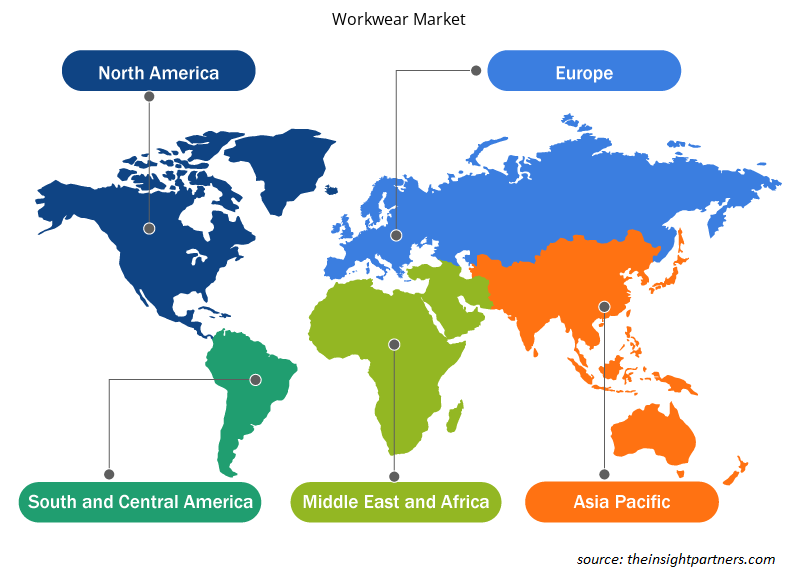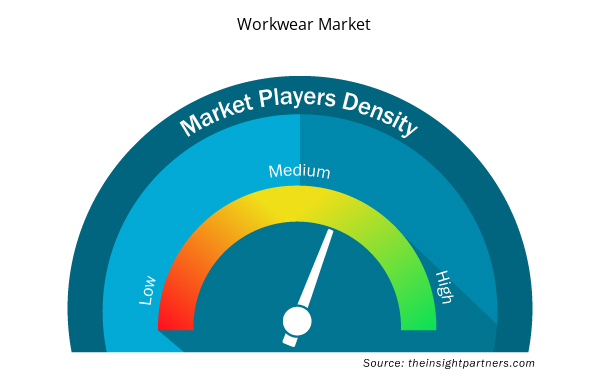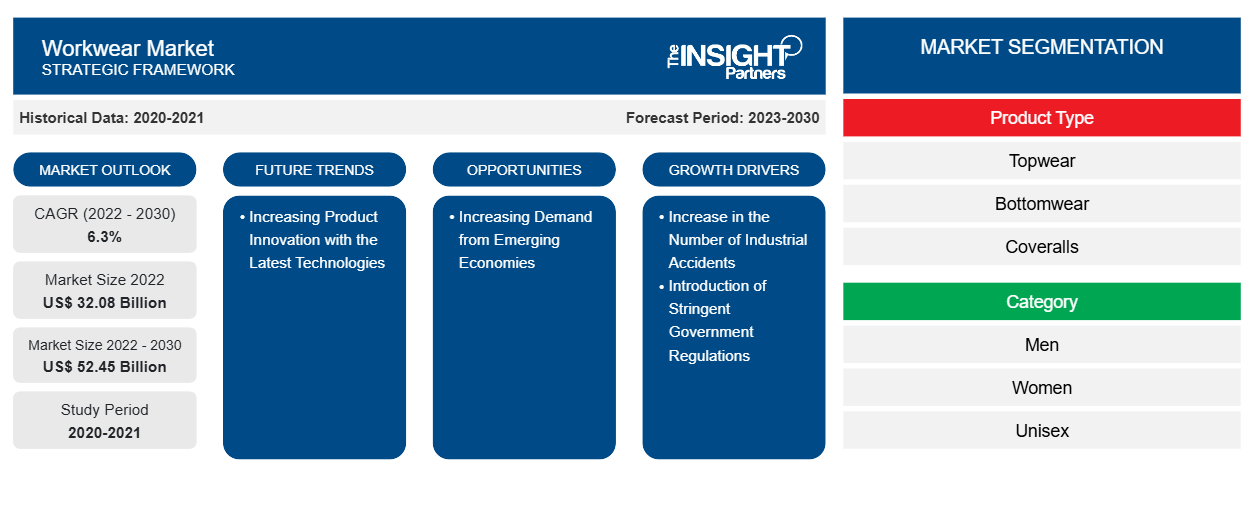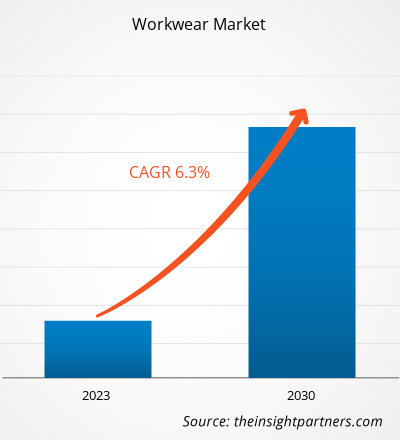[調査レポート] 作業服市場規模は、2022年の320億7,876万米ドルから2030年には524億4,815万米ドルに成長すると予測されており、2022年から2030年にかけて6.3%のCAGRを記録すると予想されています。
市場洞察とアナリストの見解:
作業服は、特に肉体労働を伴う作業で着用される安全服およびユニフォームです。作業者の安全を促進し、健康的な作業環境を確保します。作業服は、石油・ガス、化学、建設、医療、接客業、農業、鉱業など、さまざまな分野で広く使用されています。過去数年間、産業部門における労働者の安全に対する懸念が急速に高まっています。さまざまな政府および安全協会が労働者の安全を確保するための産業ガイドラインを課しており、作業服の需要が急増しています。
成長の原動力と課題:
労働災害は、さまざまな産業分野における大きな懸念事項の 1 つです。これらの事故は、人間の健康に深刻な影響を及ぼします。建設、石油・ガス、鉱業など、さまざまな業界で、世界中で多数の事故が発生しています。国際労働機関 (ILO) によると、毎年約 278 万人の労働関連死が記録されており、そのうち 240 万人が職業病に関連しています。さらに、世界中で毎年約 3 億 4,000 万件の労働災害が発生し、1 億 6,000 万人が職業病の犠牲者となっています。労働災害の増加により、雇用主は職場での従業員の健康と安全を確保するために、国内および国際機関によって定義されたいくつかの基準を採用しています。産業用作業服は、ユーザーに保護と快適さを提供し、職場での重大な死亡を回避できるように設計されており、それによって労働者の作業効率が向上します。機能的な作業服は、多様な産業基盤での作業中に安全性と耐久性を提供します。そのため、労働災害や労働関連死亡率の増加により、労働者の安全を確保するための作業服の需要が急増し、それが作業服市場の成長に貢献しています。
さらに、職場の安全性と職場で起こりうる健康被害に関する知識が労働者の間で不足していることは、世界中で大きな懸念事項です。これに対する意識を高めるために、多くの政府機関および非政府組織が労働者の健康と安全に関連するさまざまなプログラムやキャンペーンを導入しています。米国規格協会によると、北米では、米国労働省と労働安全衛生局 (OSHA) が労働安全衛生基準の分野を標準化しています。防護服の基準の開発に携わっている組織には、米国材料試験協会 (ASTM)、全米防火協会 (NFPA)、国立労働安全衛生研究所 (NIOSH)、米国規格協会 (ANSI)、米国繊維化学染色協会 (AATCC)、および産業安全装置協会 (ISEA) があります。このように、職場の安全性に関する意識の高まりが作業服市場の成長を大きく促進しています。
要件に合わせてレポートをカスタマイズする
このレポートの一部、国レベルの分析、Excelデータパックなど、あらゆるレポートを無料でカスタマイズできます。また、スタートアップや大学向けのお得なオファーや割引もご利用いただけます。
- このレポートの主要な市場動向を入手してください。この無料サンプルには、市場動向から見積もりや予測に至るまでのデータ分析が含まれます。
レポートのセグメンテーションと範囲:
世界の作業服市場は、製品タイプ、カテゴリ、流通チャネル、最終用途、および地域に基づいてセグメント化されています。製品タイプ別に見ると、市場はトップス、ボトムス、カバーオールに分かれています。カテゴリに基づいて、市場は男性、女性、ユニセックスに分かれています。流通チャネルに基づいて、市場は卸売業者、スーパーマーケットとハイパーマーケット、専門店、およびオンラインプラットフォームに分かれています。最終用途に基づいて、作業服市場は建設、石油とガス、化学、ヘルスケア、その他に分かれています。地理に基づいて、北米(米国、カナダ、メキシコ)、ヨーロッパ(ドイツ、フランス、イタリア、英国、ロシア、その他のヨーロッパ)、アジア太平洋(オーストラリア、中国、日本、インド、韓国、その他のアジア太平洋)、中東およびアフリカ(南アフリカ、サウジアラビア、UAE、その他の中東およびアフリカ)、南米および中米(ブラジル、アルゼンチン、その他の南米および中米)に分割されています。
セグメント分析:
製品タイプに基づいて、作業服市場はトップス、ボトムス、カバーオールに分類されます。カバーオールセグメントは、予測期間中に最高のCAGRを記録すると予想されます。カバーオールは、職場で全身を保護するために着用されるシングルまたはダブルの衣服です。これらのカバーオールは、主にナイロン、綿、ポリアミド繊維で作られています。職業上の危険が高いため、塗料やコーティング、石油やガスなどの化学処理プラントや業界で一般的に使用されています。これらの要因がカバーオールセグメントの市場成長を促進します。
地域分析:
地理に基づいて、作業服市場は、北米、ヨーロッパ、アジア太平洋、南米および中米、中東およびアフリカの5つの主要地域に分割されています。北米は世界市場を支配しており、この地域の市場は2022年に83億6,000万米ドルと評価されました。アジア太平洋アメリカの市場は、予測期間中に7.1%のCAGRを記録すると予想されています。 2021年、国際労働機関(ILO)は、アジア太平洋地域で毎年110万人以上が労働災害や仕事関連の病気で命を落としていると述べました。インドなどのさまざまなAPAC諸国では、保護が最も少なく、情報が最も少なく、訓練が最も少ない労働者がいます。女性、子供、障害のある労働者、移民労働者、少数民族が最も影響を受けている人口であり、労働災害に巻き込まれることがよくあります。したがって、そのような労働災害や怪我を減らすために、建設、製造、石油・ガスなどのいくつかの業界では、従業員の労働安全に大規模な投資を行っています。このように、作業服の需要が高いため、作業服市場はアジア太平洋地域で大幅に成長しています。
業界の発展と将来の機会:
作業服市場で活動する主要企業が行っている取り組みは以下の通りです。
- 2020 年 2 月、Honeywell International Inc. と Tech Mahindra Limited は、業界をリードするデジタル テクノロジーを活用した「未来の工場」の開発と構築に向けた提携を発表しました。このコラボレーションは、デジタル変革と、製造業界の顧客がさらに迅速に規模を拡大できるようにすることに重点が置かれています。
- 2020 年 7 月、Loyal Textile Mills Limited は、特に SARS-CoV-2 ウイルスに対する抗菌作用から保護するための再利用可能な PPE、マスク、防護服の新製品ラインである Viral Shield を発表しました。
作業服市場の地域別分析
予測期間を通じて作業服市場に影響を与える地域的な傾向と要因は、Insight Partners のアナリストによって徹底的に説明されています。このセクションでは、北米、ヨーロッパ、アジア太平洋、中東、アフリカ、南米、中米にわたる作業服市場のセグメントと地理についても説明します。

- 作業服市場の地域別データを入手
作業服市場レポートの範囲
| レポート属性 | 詳細 |
|---|---|
| 2022年の市場規模 | 320.8億米ドル |
| 2030年までの市場規模 | 524.5億米ドル |
| 世界のCAGR(2022年 - 2030年) | 6.3% |
| 履歴データ | 2020-2021 |
| 予測期間 | 2023-2030 |
| 対象セグメント | 製品タイプ別
|
| 対象地域と国 | 北米
|
| 市場リーダーと主要企業プロフィール |
|
ワークウェア市場のプレーヤー密度:ビジネスダイナミクスへの影響を理解する
作業服市場は、消費者の嗜好の変化、技術の進歩、製品の利点に対する認識の高まりなどの要因により、エンドユーザーの需要が高まり、急速に成長しています。需要が高まるにつれて、企業は提供品を拡大し、消費者のニーズを満たすために革新し、新たなトレンドを活用し、市場の成長をさらに促進しています。
市場プレーヤー密度とは、特定の市場または業界内で活動している企業または会社の分布を指します。これは、特定の市場スペースに、その規模または総市場価値と比較して、どれだけの競合相手 (市場プレーヤー) が存在するかを示します。
作業服市場で事業を展開している主要企業は次のとおりです。
- カーハート株式会社
- アラマーク
- アルシコグループ
- アレクサンドラ
- A.ラフォンSAS
免責事項:上記の企業は、特定の順序でランク付けされていません。

- ワークウェア市場のトップキープレーヤーの概要を入手
COVID-19パンデミックの影響:
COVID-19パンデミックは、さまざまな国のほぼすべての産業に悪影響を及ぼしました。北米、ヨーロッパ、アジア太平洋(APAC)、中南米、中東アフリカ(MEA)でのロックダウン、旅行制限、事業停止により、いくつかの最終用途産業企業の成長が妨げられました。製造ユニットの停止により、世界のサプライチェーン、生産活動、配送スケジュール、必須および非必須の製品の販売が混乱しました。2020年には、さまざまな企業で製品の配送が遅れ、製品販売が低迷し、作業服市場の妨げとなりました。また、労働力不足、輸出入禁止、原材料の供給不足により、COVID-19パンデミック中に世界中で業務やプロセスが停止しました。これらの要因は、パンデミック中の作業服市場の成長に悪影響を及ぼしました。
しかし、2021年には、いくつかの政府が以前に課していた制限を撤廃したため、さまざまな経済が活動を再開し、世界市場にプラスの影響を与えました。さらに、製造業者はフル稼働を許可され、需要と供給のギャップを克服するのに役立ちました。
競争環境と主要企業:
Carhartt、Inc.、Aramark、Alisco Group、Alexandra、3M、A. LAFONT SAS、Fristads Kansas Group、Hultafors Group、Lakeland Industries、Inc. は、世界の作業服市場で活動している著名な企業です。これらの市場プレーヤーは、戦略的開発イニシアチブを採用して事業を拡大し、作業服市場の成長をさらに促進しています。
- 過去2年間の分析、基準年、CAGRによる予測(7年間)
- PEST分析とSWOT分析
- 市場規模価値/数量 - 世界、地域、国
- 業界と競争環境
- Excel データセット


- Bioremediation Technology and Services Market
- UV Curing System Market
- Europe Industrial Chillers Market
- Integrated Platform Management System Market
- Artificial Intelligence in Healthcare Diagnosis Market
- Drain Cleaning Equipment Market
- Medical Enzyme Technology Market
- Embolization Devices Market
- Medical Audiometer Devices Market
- Adaptive Traffic Control System Market

Report Coverage
Revenue forecast, Company Analysis, Industry landscape, Growth factors, and Trends

Segment Covered
This text is related
to segments covered.

Regional Scope
North America, Europe, Asia Pacific, Middle East & Africa, South & Central America

Country Scope
This text is related
to country scope.
よくある質問
Based on the end use, healthcare segment is projected to grow at the fastest CAGR over the forecast period. The healthcare industry is one of the prominent end users of workwear. There is a global shortage of workforce in the healthcare industry. Hence, the rising investment in healthcare workforces is driving the workwear market worldwide.
North America accounted for the largest share of the global workwear market. Increasing cases of occupational injuries, an increase in the number of surgeries and occupational deaths, high demand for safety apparel, growing expenditure on work safety by the end users such as oil and gas, food, automotive, and the presence of major market players are some of the prominent factors propelling the workwear market growth in North America.
Based on product type, topwear segments mainly have the largest revenue share. The topwear segment mainly includes shirts, t-shirts, jackets, and aprons. They are often made from cotton, silk, wool, polyester, polyamide, nylon, and acrylic fibers. The growth of the corporate sector is a major driving factor for the topwear segment as internal policies allow an employer to set dress codes that the employees are required to follow.
The growth of the workwear market is directly influenced by the increasing demand from emerging economies across the globe. Various emerging economies such as China, India, Indonesia, and Malaysia are experiencing rapid development in various industrial sectors such as construction, chemicals, healthcare, and mining. Thus, rapid development in industrial sectors of emerging economies is anticipated to pose a growth opportunity for the workwear market during the forecast period.
Increasing industrial accidents and work-related mortality has surged the demand for the use of workwear to ensure the workers’ safety, which, in turn, is contributing to the market's growth.
The major players operating in the global workwear market are Carhartt, Inc.; ARAMARK; ALSICO GROUP; Alexandra; A. LAFONT SAS; 3M; Fristads; Honeywell International Ltd.; Hultafors Group; and Lakeland Inc.
Trends and growth analysis reports related to Consumer Goods : READ MORE..
The List of Companies - Workwear Market
- Carhartt, Inc.
- ARAMARK
- ALSICO GROUP
- Alexandra
- A. LAFONT SAS
- 3M
- Fristads
- Honeywell International Ltd.
- Hultafors Group
- Lakeland Inc
The Insight Partners performs research in 4 major stages: Data Collection & Secondary Research, Primary Research, Data Analysis and Data Triangulation & Final Review.
- Data Collection and Secondary Research:
As a market research and consulting firm operating from a decade, we have published and advised several client across the globe. First step for any study will start with an assessment of currently available data and insights from existing reports. Further, historical and current market information is collected from Investor Presentations, Annual Reports, SEC Filings, etc., and other information related to company’s performance and market positioning are gathered from Paid Databases (Factiva, Hoovers, and Reuters) and various other publications available in public domain.
Several associations trade associates, technical forums, institutes, societies and organization are accessed to gain technical as well as market related insights through their publications such as research papers, blogs and press releases related to the studies are referred to get cues about the market. Further, white papers, journals, magazines, and other news articles published in last 3 years are scrutinized and analyzed to understand the current market trends.
- Primary Research:
The primarily interview analysis comprise of data obtained from industry participants interview and answers to survey questions gathered by in-house primary team.
For primary research, interviews are conducted with industry experts/CEOs/Marketing Managers/VPs/Subject Matter Experts from both demand and supply side to get a 360-degree view of the market. The primary team conducts several interviews based on the complexity of the markets to understand the various market trends and dynamics which makes research more credible and precise.
A typical research interview fulfils the following functions:
- Provides first-hand information on the market size, market trends, growth trends, competitive landscape, and outlook
- Validates and strengthens in-house secondary research findings
- Develops the analysis team’s expertise and market understanding
Primary research involves email interactions and telephone interviews for each market, category, segment, and sub-segment across geographies. The participants who typically take part in such a process include, but are not limited to:
- Industry participants: VPs, business development managers, market intelligence managers and national sales managers
- Outside experts: Valuation experts, research analysts and key opinion leaders specializing in the electronics and semiconductor industry.
Below is the breakup of our primary respondents by company, designation, and region:

Once we receive the confirmation from primary research sources or primary respondents, we finalize the base year market estimation and forecast the data as per the macroeconomic and microeconomic factors assessed during data collection.
- Data Analysis:
Once data is validated through both secondary as well as primary respondents, we finalize the market estimations by hypothesis formulation and factor analysis at regional and country level.
- Macro-Economic Factor Analysis:
We analyse macroeconomic indicators such the gross domestic product (GDP), increase in the demand for goods and services across industries, technological advancement, regional economic growth, governmental policies, the influence of COVID-19, PEST analysis, and other aspects. This analysis aids in setting benchmarks for various nations/regions and approximating market splits. Additionally, the general trend of the aforementioned components aid in determining the market's development possibilities.
- Country Level Data:
Various factors that are especially aligned to the country are taken into account to determine the market size for a certain area and country, including the presence of vendors, such as headquarters and offices, the country's GDP, demand patterns, and industry growth. To comprehend the market dynamics for the nation, a number of growth variables, inhibitors, application areas, and current market trends are researched. The aforementioned elements aid in determining the country's overall market's growth potential.
- Company Profile:
The “Table of Contents” is formulated by listing and analyzing more than 25 - 30 companies operating in the market ecosystem across geographies. However, we profile only 10 companies as a standard practice in our syndicate reports. These 10 companies comprise leading, emerging, and regional players. Nonetheless, our analysis is not restricted to the 10 listed companies, we also analyze other companies present in the market to develop a holistic view and understand the prevailing trends. The “Company Profiles” section in the report covers key facts, business description, products & services, financial information, SWOT analysis, and key developments. The financial information presented is extracted from the annual reports and official documents of the publicly listed companies. Upon collecting the information for the sections of respective companies, we verify them via various primary sources and then compile the data in respective company profiles. The company level information helps us in deriving the base number as well as in forecasting the market size.
- Developing Base Number:
Aggregation of sales statistics (2020-2022) and macro-economic factor, and other secondary and primary research insights are utilized to arrive at base number and related market shares for 2022. The data gaps are identified in this step and relevant market data is analyzed, collected from paid primary interviews or databases. On finalizing the base year market size, forecasts are developed on the basis of macro-economic, industry and market growth factors and company level analysis.
- Data Triangulation and Final Review:
The market findings and base year market size calculations are validated from supply as well as demand side. Demand side validations are based on macro-economic factor analysis and benchmarks for respective regions and countries. In case of supply side validations, revenues of major companies are estimated (in case not available) based on industry benchmark, approximate number of employees, product portfolio, and primary interviews revenues are gathered. Further revenue from target product/service segment is assessed to avoid overshooting of market statistics. In case of heavy deviations between supply and demand side values, all thes steps are repeated to achieve synchronization.
We follow an iterative model, wherein we share our research findings with Subject Matter Experts (SME’s) and Key Opinion Leaders (KOLs) until consensus view of the market is not formulated – this model negates any drastic deviation in the opinions of experts. Only validated and universally acceptable research findings are quoted in our reports.
We have important check points that we use to validate our research findings – which we call – data triangulation, where we validate the information, we generate from secondary sources with primary interviews and then we re-validate with our internal data bases and Subject matter experts. This comprehensive model enables us to deliver high quality, reliable data in shortest possible time.


 このレポートの無料サンプルを入手する
このレポートの無料サンプルを入手する